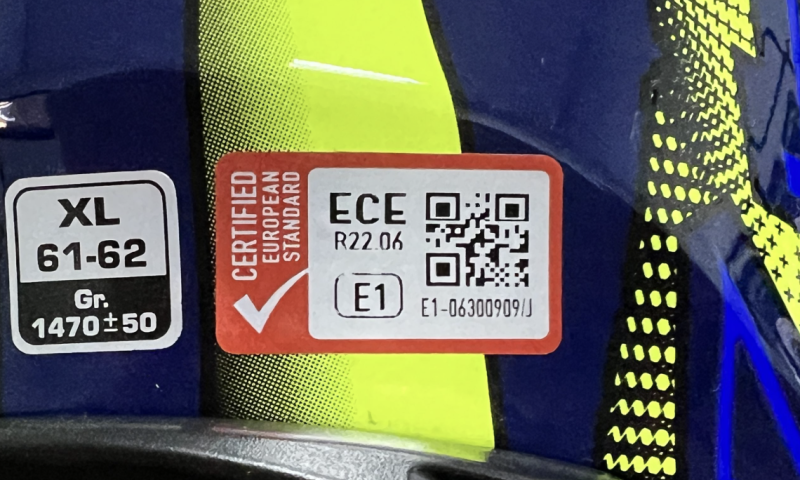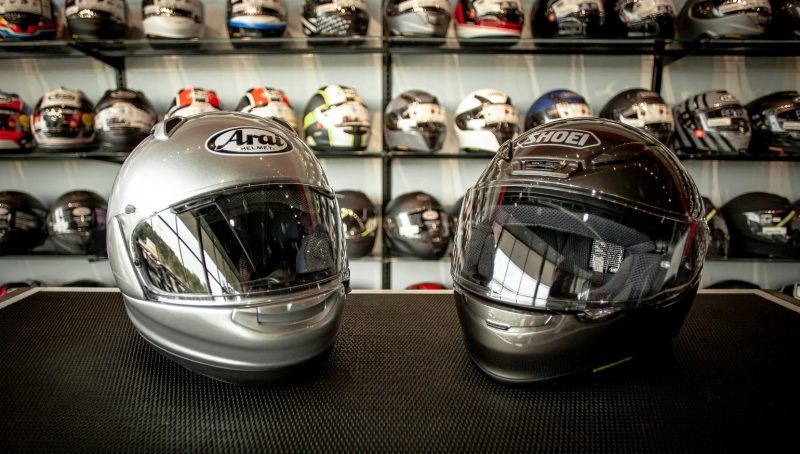A long-awaited shift in standards
Starting November 1, 2025, Singapore will recognise motorcycle helmets certified under the UNECE R22.06 standard, aligning local rules with Europe, the UK, Japan, and South Korea.
On paper, this is a big win. Riders gain access to a wider variety of helmets, labs here get more flexibility to test, and shops can avoid the cost of redundant local certification.
But the bigger story is what this means on the road. For years, motorcyclists have voiced frustration with outdated helmet rules that restricted choices and made modern features like quick-release straps effectively illegal.
 UNECE R22.06 standard on a helmet
UNECE R22.06 standard on a helmet
With the new framework, those frustrations may finally ease. Yet whether this translates to safer roads is a question worth asking.
Safer helmets, or just more options?
The new UNECE standard brings stronger protections, including rotational impact absorption and stricter vision requirements.
These updates aren’t trivial. For instance, in Singapore, head injuries remain one of the leading causes of motorcyclist fatalities, and helmets are often the difference between walking away and not surviving.
As Rex Tan, President of the Singapore Motor Cycle Trade Association (SMCTA), put it, “We should hopefully see better quality helmets being used by more riders… a step up in improving safety.”
Retailers eye more diversity in the market
Retailers see this as both an opportunity and a challenge. James Lim, Director of Hodaka Motoworld, told us that while there may be “temporary price reductions, especially during the transition period,” Singapore’s already competitive helmet market means prices are unlikely to stay lower in the long run.
What will change, however, is variety.
Shops can now bring in helmets that cater to different demographics. As Mr Lim explained, this means “better-fitting models for ladies or teenagers, and more colours and designs that customers have been asking for.”
From our perspective, this diversity matters. Many riders have long complained that helmets here are designed with European or American markets in mind, leaving Asian riders with poor fit and discomfort in Singapore’s climate.
Wider options could encourage riders to wear helmets properly, something as simple as a snug fit can significantly affect protection during a crash.
But the transition isn’t without challenges. Until 2026, both old and new standards will coexist. Lim warned that “customers might mistake some helmets as approved or try to bring them in from overseas,” creating confusion.
This is where clear labelling and retailer education will be critical.
Still, it’s important to recognise that better helmets don’t automatically equal safer riders.
As our team at ROADS.sg has covered in past accident reports, fatalities are often compounded by speed, visibility, and poor riding behaviour. Helmets can mitigate, not eliminate, those risks.
Riders remain pragmatic
Among bikers, enthusiasm is mixed with realism. Popular motorcycling content creator Wes from @wesmybike said the change “definitely opens the doors to more possibilities like buying Shoei or Arai helmets overseas… especially since they’re usually cheaper, and now officially legal.”
 Shoei and Arai Helmets (Photo : Revzilla)
Shoei and Arai Helmets (Photo : Revzilla)
But he was less convinced about the government’s five-year replacement advice: “Most riders already know helmets have a shelf life. It’s whether they feel the need or not.”
Here’s the insight: riders are savvy consumers.
Many already look for ECE-approved helmets at the entry-level $100 range.
Beyond that, choices are influenced by comfort, style, and personal preference. The update will likely reshape where helmets are bought (more overseas imports, more premium models locally) rather than how often riders replace them.
And while new features like quick-release straps sound appealing, @wesmybike reminded us that riders don’t see them as game-changers: “I’m a double D-ring kinda guy… but emergency pull tabs are always helpful.”
In other words, what matters most is not gadgetry, but whether helmets genuinely hold up in real-world crashes.
What this means for Singapore’s roads
This update represents progress, a global alignment, broader consumer choice, and an overdue refresh of outdated rules.
But helmets are only one part of the road safety equation.
For authorities, the challenge is ensuring riders can easily identify legitimate helmets and avoid counterfeits.
For retailers, it’s about bridging the education gap and guiding customers through the transition.
And finally, for riders, it’s a reminder that a helmet, no matter how advanced, cannot substitute safe riding habits.
As Mr Tan of SMCTA highlighted, the hope is that better quality helmets will gradually become the norm. But as our team has seen time and again, the biggest safety gains still come when drivers check their blind spots and riders ride within their limits.
Helmets may be evolving. Whether behaviour evolves alongside them will decide if Singapore’s roads truly become safer.
Have a story to share?
Accidents occur frequently, but as responsible road users, we can collectively contribute to reducing their frequency.
If you or someone you know has a video or story to share, please do not hesitate to email us at writer@roads.sg
Together, we can all contribute to creating safer roads for everyone.
================
Get comprehensive cover at a lower price today! Receive up to S$400 worth of petrol vouchers with AIG. T&Cs apply. Protected up to specified limits by SDIC.
Get a quote now! www.aig.sg/roads








